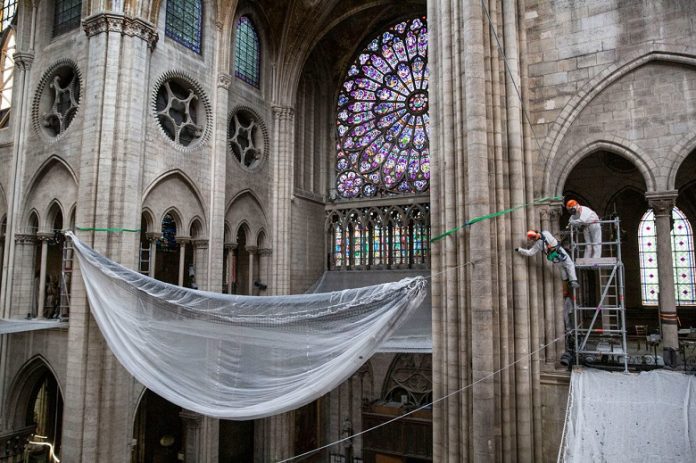Eight restoration scientists put on hard hats and heavy-duty boots and stepped inside the blackened shell of Notre Dame de Paris, the world’s most famous cathedral. Ten days earlier, a fire had swept through its attic, melted its roof, and sent its spire plunging like an arrow into the heart of the sacred space. Now, it was silent but for the flutter of house sparrows. The space, normally sweet with incense, was acrid with ash and stale smoke. Light beamed through voids in the vaulted stone ceiling, cutting through the gloom and illuminating piles of debris on the marble floor.
Yet the scientists, called in by France’s Ministry of Culture to inspect the damage and plan a rescue, mostly felt relief—and even hope. Rattan chairs sat in tidy rows, priceless paintings hung undamaged, and, above the altar, a great gold-plated cross loomed over the Pietà, a statue of the virgin Mary cradling the body of Jesus. “What matters isn’t the roof and vault so much as the sanctuary they protect,” says Aline Magnien, director of the Historical Monuments Research Laboratory (LRMH). “The heart of Notre Dame had been saved.”
On 15 April 2019, an electrical short was the likely spark for a blaze that threatened to burn the 850-year-old cathedral to the ground. Following a protocol developed for just such a disaster, firefighters knew which works of art to rescue and in which order. They knew to keep the water pressure low and to avoid spraying stained glass windows so the cold water wouldn’t shatter the hot glass.
But even though their efforts averted the worst, the emergency was far from over. More than 200 tons of toxic lead from the roof and spire was unaccounted for. And the damage threatened the delicate balance of forces between the vault and the cathedral’s flying buttresses: The entire building teetered on possible collapse.
At LRMH, the laboratory tasked with conserving all the nation’s monuments, Magnien and her 22 colleagues apply techniques from geology to metallurgy as they evaluate the condition of Notre Dame’s stone, mortar, glass, paint, and metal. They aim to prevent further damage to the cathedral and to guide engineers in the national effort to restore it. President Emmanuel Macron has vowed to reopen Notre Dame by 2024, and he has appointed a military general to lead the operation, which involves many government agencies and has drawn philanthropic pledges of about €1 billion.
But it is the LRMH scientists who lead the critical work of deciding how to salvage materials and stitch the cathedral back together. And even as they try to reclaim what was lost, they and others are also taking advantage of a rare scientific opportunity. The cathedral, laid bare to inspection by the fire, is yielding clues to the mysteries of its medieval past. “We’ve got 40 years of research coming out of this event,” says LRMH Assistant Director Thierry Zimmer.
Across centuries marked by war and disease, Notre Dame has witnessed cycles of decline and renewal before. The LRMH scientists hope that when the vaults and buttresses are again dry and sound, the lead accounted for, and the great cathedral’s history and resilience understood more deeply than before, grief and loss will once again turn to joy and gratitude.
“Certainly this is a difficult period emotionally, but there’s an extraordinary unity of people coming together to not only save this monument, but to learn from it,” Magnien says. “Notre Dame will be restored! Its artwork, stone, and stained glass will be cleaned; it will be more luminous and beautiful than before.”
“Notre Dame will come out of this experience enriched,” she says. “And so will we.”
Source: www.sciencemag.org








































